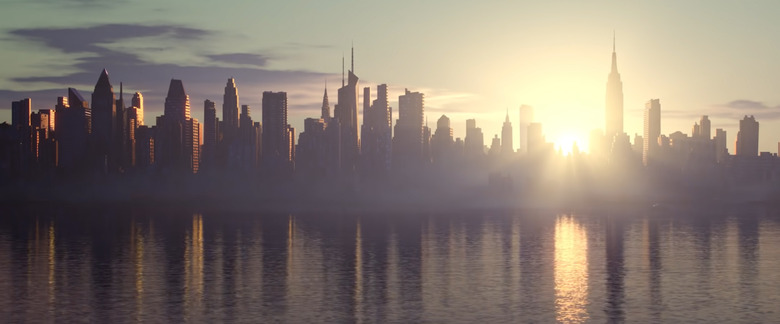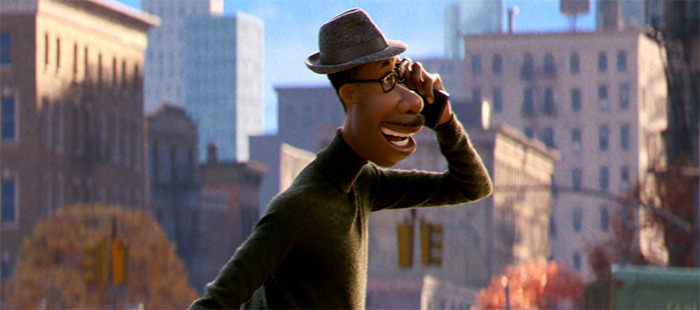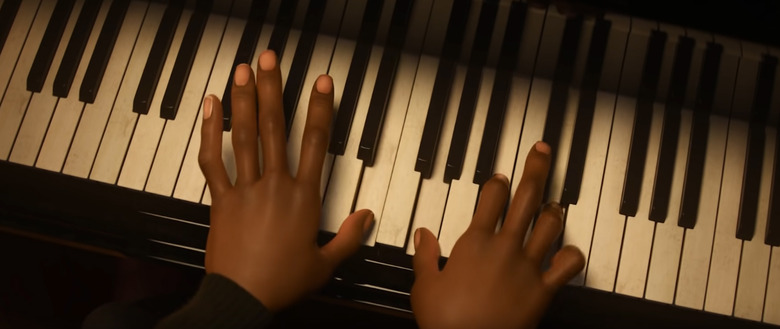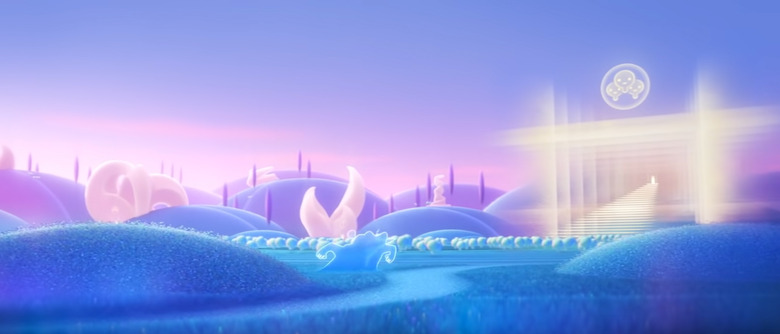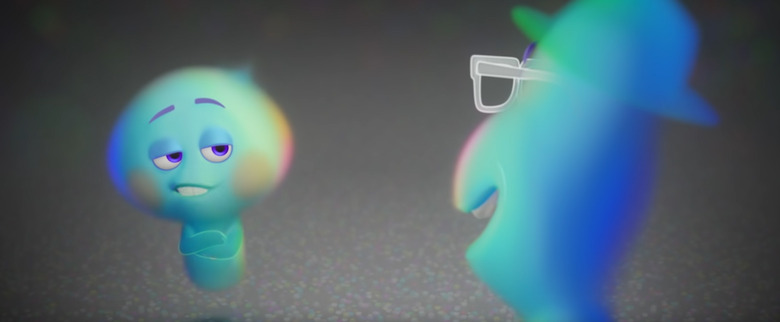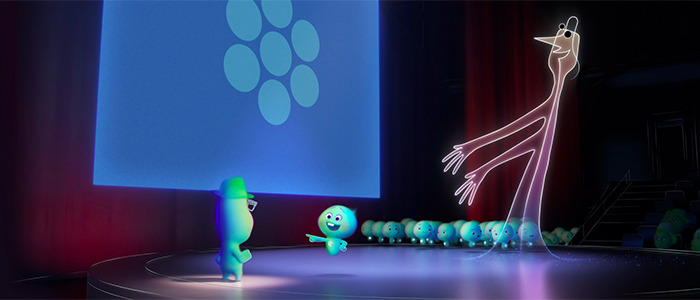The Making Of Pixar's 'Soul': From The Real World To The Great Before And Beyond
Pixar's Soul is no longer coming to theaters in the United States. Instead, the movie is being released through Disney+ on Christmas Day. This is a real shame, because the journey that middle school band teacher and aspiring jazz musician Joe Gardner (Jamie Foxx) takes from New York City to the ethereal plane of The Great Before is full of mesmerizing and stunning animation, some of which takes Pixar in surprising new directions. And it wasn't easy to pull off either.
Director Pete Docter, co-director/writer Kemp Powers, and the entire Pixar team were tasked with creating this world where new souls get their personalities, quirks, and interests before they go to Earth. It not only required endless imagination, but technical innovation, not to mention a stark contrast to the incredibly life-like environments of the real world. And the real world presented its own challenges too, especially when it came to animating Joe Gardner's passion for music, which includes some meticulous, fast-paced piano-playing and other instrumental excitement.
So how did they do it? Back in September, /Film was invited to partake in some virtual presentations from the filmmakers to learn about some of the amazing work Pixar put into this movie. So let's take a closer look at the making of Pixar's Soul.
Before we get into the making of Pixar, let's refresh your memory with the trailer and official synopsis of Pixar's Soul:
Joe Gardner (Jamie Foxx) is a middle-school band teacher who gets the chance of a lifetime to play at the best jazz club in town. But one small misstep takes him from the streets of New York City to The Great Before – a fantastical place where new souls get their personalities, quirks and interests before they go to Earth. Determined to return to his life, Joe teams up with a precocious soul, 22 (Tina Fey), who has never understood the appeal of the human experience. As Joe desperately tries to show 22 what's great about living, he may just discover the answers to some of life's most important questions.
New York City, The Jazz Capital of America
Jazz is at the center of Joe Gardner's story in Soul. It's what drives him everyday. And Pixar knew that the only place to begin this story was in New York City.
Director Pete Docter said: "Though jazz didn't originate there, New York is the jazz capital of America. It is a center of culture, full of immigrants and influences from around the world. It's a rich and vibrant place to feature a film." Co-director Kemp Powers added, "Jazz is a uniquely American artform, and New York City has one of the strongest histories of jazz—some of the most famous musicians are known for their performances in New York City."
But New York City brings a certain kind of energy and style outside of jazz too. As production designer Steve Pilcher said, "It's solid, physical and reflective with lots of local color. It's very tactile with a history of wear and tear. Buildings and railings and pavement are weathered or bleached. Nothing's really perfect in this world. It's very organic and interesting."
All of this comes through in the lifelike textures in every single shot. Whether it's the grit of the sidewalk or the shimmer of a saxophone, the New York in Soul looks so phenomenally real that it risks making the stylized animated characters look out of place. The jazz club and middle school band room created in computer animation would be indistinguishable from photographs of these real locations if it wasn't for the animated characters. But no matter how stylized these characters look, they still feel real at their core.
Bringing Joe Gardner to Life
Joe Gardner is the first Black lead character in in a Pixar animated film, so plenty of eyes are on how he's depicted. Adding to the authenticity, Powers inserted some of himself into Joe. Powers is from Brooklyn, and though Joe is from Queens, the writer was able to incorporate plenty of his own knowledge and experiences into the story. That includes time he spent as a jazz critic. So Joe easily feels like a richly layered and authentic character, from his passion for music to the beauty he finds in everyday life.
"We had many meetings and discussions about Joe as a team, where he grew up, the important people in his life, what made him tick, and then I reached into my own past and life experiences and tried to put that down on paper," Powers said.
However, Powers also went out of his way to tell Docter and producer Dana Murray that he shouldn't represent every single Black person's experience. He said, "It was very important that the film transcended any one person's life." So Pixar brought in cultural consultants like
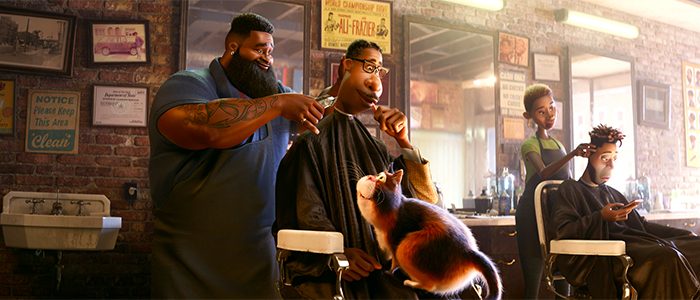
The barbershop scene in particular was an important one to Powers. Citing the incredible animated hair on the furry blue monster Sully in Pete Docter's movie Monsters Inc., Powers remembered imploring Pete to have a scene set in a barbershop so they could not only recreate the unique experience of being in a Black barbershop, but also meticulously bring the texture and look of Black hair to life in animation. Powers said, "I think, internally, if you ask a lot of the folks who worked on it, it became one of everyone's favorite scenes in the entire movie because we had a great deal of fun with it."
One of the writer's favorite parts of this scene was all of the hip-hop centric Easter eggs you'll find in the background. In particular, there's a poster featuring a bunch of Black men's hairstyles that Powers had a hand in creating with Pixar's animators. Powers said, "Just being able to show black hair being trimmed, shaped, cut different shapes, different colors in a Pixar film was really a joy."
Animating Joe's Passion for Music
Even though this is an animated movie with plenty of fantastical elements, Pixar doesn't cut corners when it comes to depicting things realistically. One of their biggest challenges in Soul was showing Joe Gardner and various other characters as they played music. For this, they turned to another cultural consultant, musician Jon Batiste, who you might know as the band leader on The Late Show with Stephen Colbert. Ruffin said that in addition to offering insights on jazz music in general, he also played live performances that they could observe in order to animate accurately. The animator explained:
"We also recorded video reference of Jon Batiste's hands as he played the piano, and by having this information not only did it allow us to inspect hand movement and finger articulation, but it also served as a visual roadmap, and by having these resources available to us, it was up to us to animate that performance through Joe Gardner frame by frame."
Animators not only use video reference, but also MIDI (Musical Instrument Digital Interface) data to accurately represent the music being played. After a first pass of general hand placement is configured, animators then add the various layers to give nuance to the details of the hands and the piano, or whatever instrument a character might be playing.
Along with the accurate representation of the music, there's also the more abstract side when Joe gets "in the zone," literally and figuratively taking him to another plane as he really taps into his passion. It's an incredible meshing of the real world and the surreal world that Joe finds himself stuck in in the first act of the movie.
Venturing Into The Great Before
New York City is recreated in Soul with such scrupulous detail, and while that's a difficult task for animators, it's even harder to come up with a place that doesn't exist. That's exactly what Pixar had to do with the world known as The Great Before, where souls pick up their personality traits before going to Earth. Docter said, "Worlds like this are super fun to put together, but super challenging, too, because they could be anything."
While New York is full of definitive structure and organized chaos, The Great Before is a soft, wild world that wouldn't feel out of place in a Dr. Seuss book. As production designer Steve Pilcher describes it:
"Almost everything has a degree of blur on it. Everything is very soft and ethereal and somewhat transparent. It is predominantly a very pastel palette, somewhat desaturated. There's something that looks like grass, but it's not really grass. It's soft and almost featherlike—translucent in the way it moves."
There are parts of The Great Before that come from the real world, but that's only because the souls have to interact with things from Earth in order to determine their personalities. But these items and places had to look completely different from the real world. Pilcher said, "We bleached the color in the Hall of Everything—where souls go to interact with possible interests. Everything there is recognizable, but there's no color in it unless you interact with it." But Docter didn't want to go overboard with how wild this ethereal plane was. Pilcher remembered:
"For Pete and his team, showing something new was more about restraint than about adding all the bells and whistles. The world is very deceptively simple, big bold beautiful shapes, abstract buildings that look like none you've ever seen on Earth. It takes guts to try to communicate and idea with less, but if done right it can end up saying a lot more."
It's probably a good thing they kept The Great Before a little less complicated, because the characters that populate The Great Before brought some immense challenges.
What Does a Soul Look Like?
Along with create The Great Before, Pixar also had to come up with their idea for what a soul actually looks like before it's inside of a human body. They need human features to express themselves, but that's only so humans can actually grasp the reality (or lack thereof) of this plane of existence. And getting just the right look for the souls proved to be rather difficult.
Docter mentioned all the research that was conducted on various religious teachings that often described souls as "vaporous, non-physical, formless" beings that were essentially the equivalent of a breath of air. But how do you draw that?
Some of their early designs were inspired by a drawing that Pete Docter did early on in development:

From there, they came up with this interesting array of designs, using the color spectrum and playing with light and darkness. Here are some of the various concepts for what a soul might look like in The Great Before:
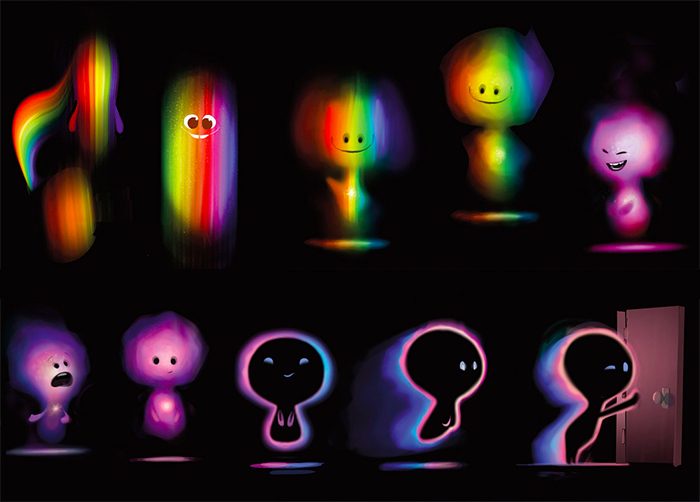
But animators caught a big break when they stumbled upon a substance called aerogel, the lightest solid material on Earth. It's used in the aerospace industry and also has various commercial uses. You can find out more about it over here. That's what they decided to use as the basis of how a soul's "body" would look.
However, even with this breakthrough, they still had a lot to figure out with how to animate a character that is somewhat transparent and thus made it difficult to have any defining features. Producer Dana Murray recalls that they came to the determination that they needed to be able to create more clear facial expressions, and the movement of a soul's hands and fingers needed to be more defined. Murray explained:
"We added line work to help to define the edges that might otherwise be too fuzzy or that you couldn't see very clearly."
If you look at the character of 22 as she moves in the trailer, you'll see some lighter line definition that appears whenever her hands move in front of her body or with certain facial expressions. Animator Jude Brownbill explained further, "We noticed that clarity was being lost in the face and in the hands, so technical directors in articulation, shading, and tools set about solving this in a classic case of art challenging the technology and technology inspiring the art."
Pixar's technical directors had to figure out how to render the edges that mattered and ignore those that didn't. As a soul moves, there are facial lines and other edges that were hand-animated to appear, disappear, and change thickness with each expression. This was all done by hand, and it took a long time to complete. So the technical directors found a way to automate the process in order to make it easier and less time-consuming. The result allowed for clarity on the face for expressions of confusion, fear and rage.
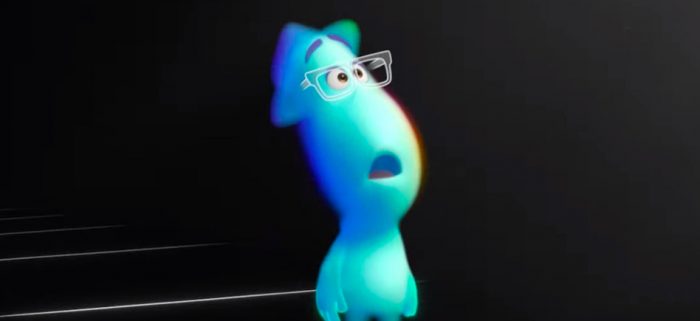
But then they had to come up with rules as to how a soul was defined in The Great Before. Most of them don't have distinguishing features. Brownbill explained:
"These are new souls who have not yet lived. They're very cute, very appealing, with simple, rounded shapes and no distinguishing features just yet. Because they've never lived on Earth, they have no concept of gravity, so they tend to float about or even fly."
But then there are souls in The Great Before who have plenty of experience on Earth. Brownbill went on:
"These are mentor souls who have lived on Earth. They are an abstraction of how they saw themselves on Earth, each with unique, distinguishing features and accessories. Because they have experienced gravity on Earth, they walk as if it exists, even though they don't really need to."
That's why Joe appears with his at and glasses in The Great Before. As for 22, you'll find that she has more defined features than the rest of the new souls getting ready to head to Earth. That's because she's been around so long and has interacted with so many mentors who have been to Earth that she knows enough about it to have evolved some teeth and a tuft of hair. She can even have legs when it's convenient for a gag. Souls don't have many restrictions when it comes to their movement and expression. But it's The Counselors who are even more mesmerizing and challenging in their depiction.
The Counselors Are Both 2D and 3D
There has to be a certain order to things in The Great Before. It may just be a construct in place so abstract concepts and beings can be more easily understood by humans, but that's more than necessary when you're trying to convey such complex ideas to kids and adults alike. Making it a little easier to understand The Great Before are The Counselors, and bringing them to life created yet another challenge for animators.
The Counselors are all named Jerry (one is voiced by Richard Ayoade), and they're in charge of The You Seminar, the process by which souls determine their personalities. They're described as being like camp counselors "wrangling dozens of new human souls, awarding them unique personalities and helping them find their spark and graduate to Earth." As an expression of the universe itself, they have endless patience and always seem to be effortlessly upbeat, but there are instances when some passive-aggressiveness seems to come through. But even so, they're always enthusiastic about their place in the universe and helping souls find their place.
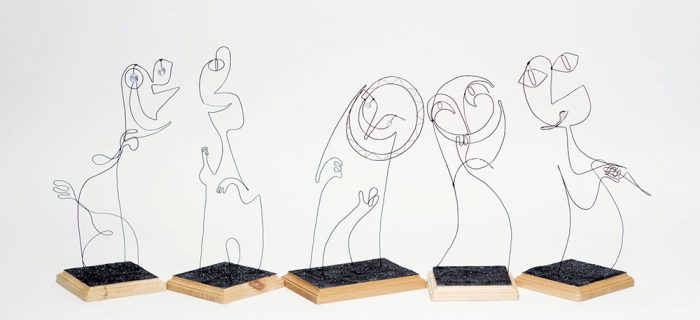

So how do you animate a being like that? Animator Bobby Podesta said it was the art department that began drawing countless forms until one that "felt both recognizable as a character, yet malleable enough to be almost anything, emerged, and that character was made up of actually a line." The result is a character that exists as a flat, contorted line in a three-dimensional space. So the next step was creating 3D sculptures that allowed animators to see what these characters would look like from different angles as they made a variety of expressions and forms, some more human than others.
You might think it's easy to animate a line into a character that can change its form into anything. But as Podesta explained:
"The technology behind creating the counselors is mind-boggling. But that's the thing about Pixar. We have some of the most talented and, quite frankly, smartest people I've ever met in this industry, and so just as the art department had explored the possibilities of what the counselors could be, the animators, we did the same.
We began exploring shapes, expressions, movements, and transitions, and the animators didn't just animate a model. I mean, they animated a design, and you can see that here. The characters captured that sense of a living line, a piece of art in a form that was understandable, yet still ethereal. So, to achieve the sense of design within the animation, our animators had to draw on their backgrounds as artists to craft a visually stunning performance, and it's that combination of being both an actor and an artist that raises the bar at Pixar to a level that we hope continues to exceed our audience's expectations."
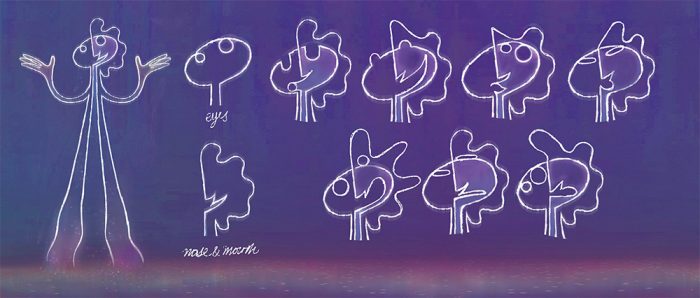
Seeing The Counselors in action is truly a spellbinding sight. It feels like you're watching a magic trick unfold in front of your eyes. The trailers don't even show the full range of motion and shapeshifting that The Counselors have, and those who have seen more were equally as impressed as I was. Executive producer Dan Scanlon (director of Monsters University and Onward) remembers how audiences reacted to The Counselors in a test screening:
"The first time I saw a screening of the film that featured the wiry three-dimensional You Seminar characters in motion, myself and other people in the theater audibly gasped. I'd never seen that type of 2-D animation done in 3-D that way before,and seeing something you've never seen before is why I go to movies."
Powers backed up those sentiments by adding, "I think they were the-the single most complex thing to do in the entire film."
***
We'll have more on Pixar's Soul in the coming weeks, including a closer look at the characters of Joe Gardner and 22, the progression of the movie from storyboard to screen, interviews with the animators and filmmakers, and more. If you haven't already, make sure you check out our reaction to the roughly 40 minutes of footage shown to us by Pixar in advance of the film's release, which is now on Christmas Day on Disney+.

